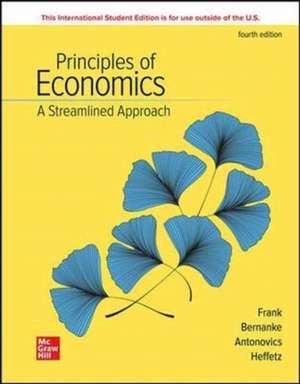ISE Principles of Economics, A Streamlined Approach
Autor Robert Frank, Ben Bernanke, Kate Antonovics, Ori Heffetzen Limba Engleză Paperback – 17 feb 2021
Fewer themes, less math rigor, and a new suite of video resources allow instructors the flexibility to teach the course they want to teach, whether it’s adopting a flipped classroom format, administering a course online, or just bringing more engaging, digital content into their lectures. Students benefit from more repetition of basic concepts and support through the interactive resources in Connect, resulting in a greater mastery and retention of core economic ideas.
With new videos and engagement tools in Connect, like Application-Based Activities, alongside SmartBook's adaptive reading experience, the 4th edition enables instructors to spend class time engaging, facilitating, and answering questions instead of lecturing on the basics. Connect is the only integrated learning system that empowers students by continuously adapting to deliver precisely what they need, when they need it, and how they need it, so that your class time is more engaging and effective.
Preț: 1279.35 lei
Preț vechi: 1346.69 lei
-5% Nou
Puncte Express: 1919
Preț estimativ în valută:
244.84€ • 254.67$ • 202.12£
244.84€ • 254.67$ • 202.12£
Carte nepublicată încă
Doresc să fiu notificat când acest titlu va fi disponibil:
Se trimite...
Preluare comenzi: 021 569.72.76
Specificații
ISBN-13: 9781260597981
ISBN-10: 1260597989
Dimensiuni: 218 x 277 x 28 mm
Greutate: 1.17 kg
Ediția:4
Editura: McGraw Hill Education
Colecția McGraw-Hill Education
Locul publicării:United States
ISBN-10: 1260597989
Dimensiuni: 218 x 277 x 28 mm
Greutate: 1.17 kg
Ediția:4
Editura: McGraw Hill Education
Colecția McGraw-Hill Education
Locul publicării:United States
Cuprins
PART
1:
Introduction
1. Thinking Like an Economist
2. Supply and Demand
PART 2: Competition and the Invisible Hand
3. Demand and Elasticity
4. Perfectly Competitive Supply
5. Efficiency, Exchange, and the Invisible Hand in Action
PART 3: Market Imperfections
6. Monopoly, Oligopoly, and Monopolistic Competition
7. Games and Strategic Behavior
8. An Introduction to Behavioral Economics
9. Externalities and Property Rights
PART 4: Economics of Public Policy
10. Using Economics to Make Better Policy Choices
PART 5: International Trade
11. International Trade and Trade Policy
PART 6: Macroeconomics: Issues and Data
12. Macroeconomics: The Bird’s-Eye View of the Economy
13. Measuring Economic Activity: GDP, Unemployment, and Inflation
PART 7: The Economy in the Long Run
14. Economic Growth, Productivity, and Living Standards
15. The Labor Market: Workers, Wages, and Unemployment
16. Saving and Capital Formation
17. Money, the Federal Reserve, and Global Financial Markets
PART 8: The Economy in the Short Run
18. Short-Term Economic Fluctuations and Fiscal Policy
19. Stabilizing the Economy: The Role of the Fed
20. Aggregate Demand, Aggregate Supply, and Inflation
PART 9: The International Economy
21. Exchange Rates and the Open Economy
1. Thinking Like an Economist
2. Supply and Demand
PART 2: Competition and the Invisible Hand
3. Demand and Elasticity
4. Perfectly Competitive Supply
5. Efficiency, Exchange, and the Invisible Hand in Action
PART 3: Market Imperfections
6. Monopoly, Oligopoly, and Monopolistic Competition
7. Games and Strategic Behavior
8. An Introduction to Behavioral Economics
9. Externalities and Property Rights
PART 4: Economics of Public Policy
10. Using Economics to Make Better Policy Choices
PART 5: International Trade
11. International Trade and Trade Policy
PART 6: Macroeconomics: Issues and Data
12. Macroeconomics: The Bird’s-Eye View of the Economy
13. Measuring Economic Activity: GDP, Unemployment, and Inflation
PART 7: The Economy in the Long Run
14. Economic Growth, Productivity, and Living Standards
15. The Labor Market: Workers, Wages, and Unemployment
16. Saving and Capital Formation
17. Money, the Federal Reserve, and Global Financial Markets
PART 8: The Economy in the Short Run
18. Short-Term Economic Fluctuations and Fiscal Policy
19. Stabilizing the Economy: The Role of the Fed
20. Aggregate Demand, Aggregate Supply, and Inflation
PART 9: The International Economy
21. Exchange Rates and the Open Economy
